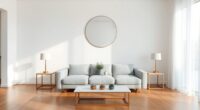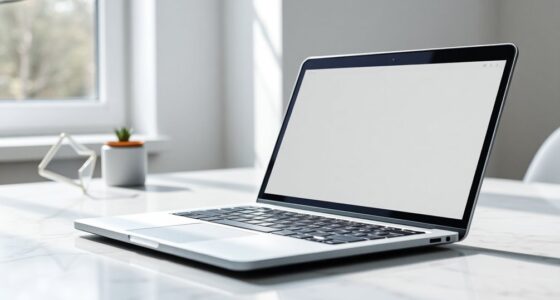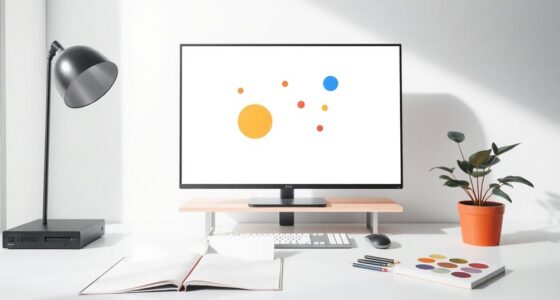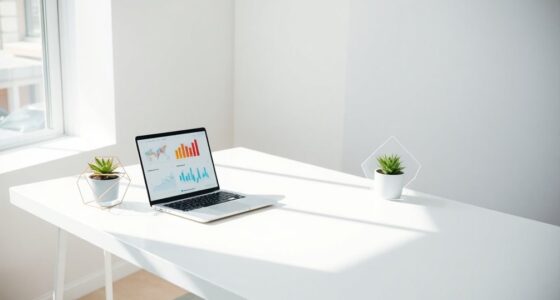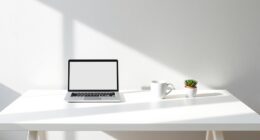In 2025, global minimalist design trends focus on bold minimalism with vibrant colors and striking typography. You'll see textured grains adding depth and warmth, appealing to your craving for authenticity. Incorporating sophisticated metallic hues, like silver and chrome, will enhance the overall aesthetic. Nostalgic elements draw on retro designs, creating familiar emotional connections. Plus, AI-powered tools will elevate creativity and personalization in design, setting the stage for exciting developments ahead. Stay tuned for more insights!
Key Takeaways
- Bold typography will dominate minimalist designs, enhancing simplicity and emphasizing key messages for stronger visual impact.
- Textured grains will be popular for adding depth and authenticity, appealing to audiences seeking warmth and a human touch.
- Metallic hues, especially silver and chrome, will introduce sophistication and striking contrasts in modern minimalist designs.
- Nostalgic elements, like geometric shapes and retro-tech details, will evoke emotional connections through familiarity and relevance.
- AI-powered design tools will enhance creativity and ideation, enabling real-time audience-targeted content and transforming design processes.
Embracing Bold Minimalism

As you explore the world of design in 2025, you'll find that embracing bold minimalism is a game changer. This approach harnesses minimalistic elements to create a stronger visual impact by focusing on fewer, yet more significant components.
Bold typography plays an essential role, enhancing simplicity while drawing attention to key messages. Expect to see vibrant color palettes that provide striking contrasts against the backdrop of impactful simplicity, making your designs stand out.
This trend encourages you to explore unique visual identities, infusing fresh perspectives into traditional aesthetics. By prioritizing clarity and focus, bold minimalism not only redefines design but also transforms how you communicate visually, ensuring your message resonates powerfully. Additionally, understanding lighting design can enhance the overall ambiance of minimalist spaces, making them feel more inviting and dynamic.
The Rise of Textured Grains
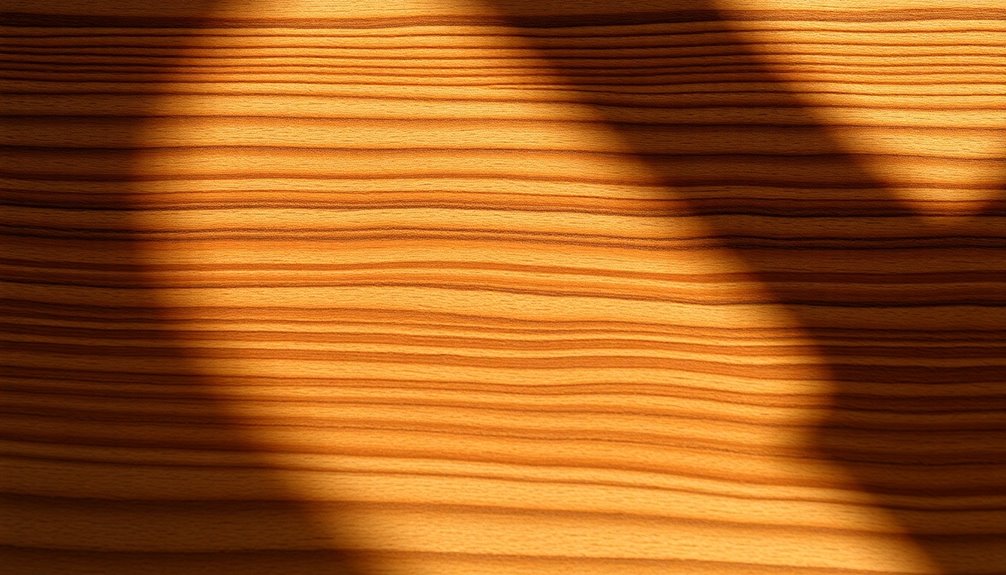
Bold minimalism sets the stage for a new trend in design: the rise of textured grains. This trend adds depth and movement, appealing to your desire for a more tactile aesthetic.
Textured grains reflect a broader craving for authenticity, contrasting the flawless imagery produced by AI. By incorporating these elements, you can create a raw, edgy feel that embraces natural aesthetics.
Textured grains embody a desire for authenticity, offering a raw, edgy aesthetic that stands apart from AI perfection.
This approach resonates with audiences seeking warmth and a human touch, making it particularly effective in branding and storytelling. As you embrace textured grains in your work, expect significant shifts in visual communication strategies across various industries in 2025. Moreover, the incorporation of natural elements can further enhance the tactile experience and promote tranquility in your designs.
It's a chance to capture audience attention and align your designs with emerging trends.
Incorporating Metallic Hues
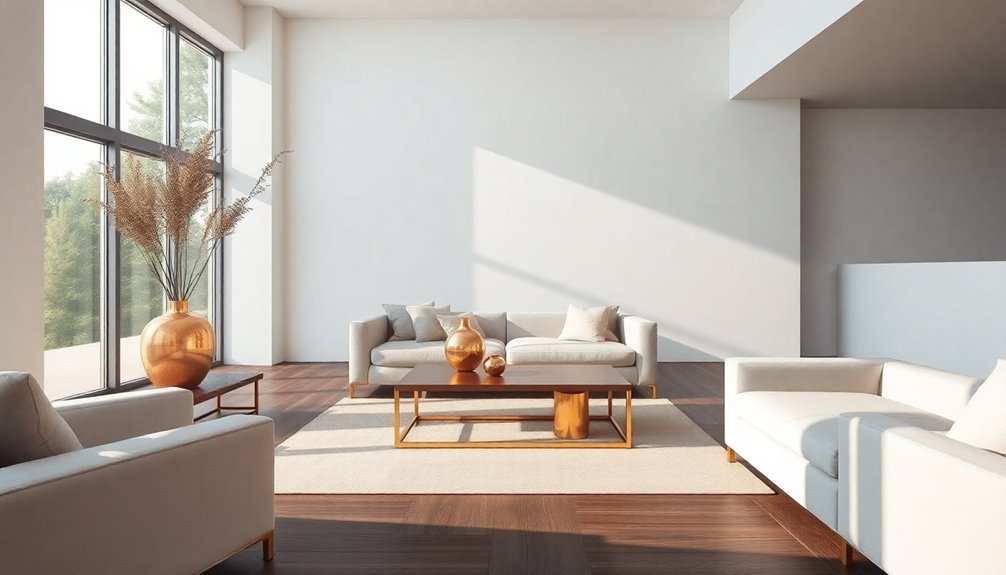
While many designers focus on clean lines and minimalism, incorporating metallic hues injects an element of sophistication that can elevate your work.
In 2025, expect silver and chrome to rise in popularity, enhancing the visual appeal of your minimalistic designs. By integrating these metallic elements, you create striking contrasts that highlight key design elements.
The Color of the Year, Future Dust—a dark blue with hints of purple and grey—will influence how metallic shades are used, adding depth to your brand identities. This luxurious touch maintains the simplicity of bold minimalism while setting your designs apart. Incorporating natural materials can further enhance the warmth and texture of your designs.
Embrace the trend of creating designs that seamlessly blend metallic hues with contrasting colors for a modern, sophisticated look that resonates across industries.
Nostalgic Design Elements

Nostalgic design elements tap into our collective memories, making them a powerful tool for modern creators. By incorporating basic geometric shapes reminiscent of early digital aesthetics, you create a sense of familiarity that resonates with audiences.
Bright color palettes and muted tones reflect the visual style of vintage digital screens, enhancing that nostalgic appeal. You might also consider using retro-tech details like pixelated fonts and ASCII art to evoke memories of past decades.
Integrating patterns and textures inspired by earlier eras blends the old with the new, offering a unique aesthetic. Ultimately, these nostalgic elements help establish emotional connections, making your designs feel both relevant and relatable in today's fast-paced world. Additionally, the rise of generative AI in creative industries can further enhance the development of nostalgic designs by providing innovative tools for artists.
AI-Powered Design Integration
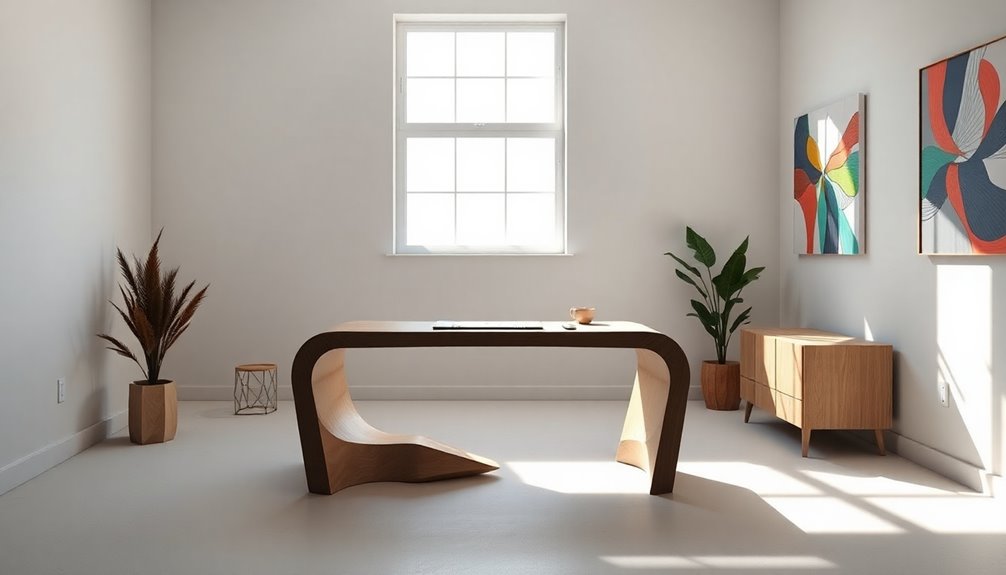
AI-powered design integration acts as a personal assistant, enhancing your creativity by providing inspiration and facilitating ideation. It's crucial to recognize how tools like Adobe's AI features enable real-time audience-targeted content, helping you craft designs that look personalized and effective.
AI integration in design serves as a creative ally, transforming inspiration into personalized, audience-focused content with ease.
Projects like Coca-Cola's 2024 campaign demonstrate machine-generated storytelling, showcasing AI's potential to build trust through compelling narratives.
The fusion of clean lines and bold fonts in your work can be revolutionized as AI quickly transforms ideas into reality. This collaboration emphasizes enhancement over replacement, ensuring a balanced approach to modern design and typography. Furthermore, the rise of AI integration in healthcare is just one example of how AI's influence is expanding across various sectors, highlighting its transformative potential.
Frequently Asked Questions
What Is the Design Style Trend in 2025?
In 2025, you'll notice a fascinating blend of minimalist and maximalist elements in design. Bold typography and vibrant colors will pop against soft gradients, creating a visually stimulating experience.
Asymmetrical layouts will draw your attention, encouraging creativity. You'll also see textured grains and hand-drawn illustrations adding depth, celebrating imperfections.
Plus, sustainable practices will be key, with brands using eco-friendly materials and storytelling to connect with your socially conscious values.
What Do You Think the Next Big Design Trend Will Be?
You might say the next big design trend will be like a refreshing change.
Expect a fusion of bold colors and minimalism that creates a striking yet inviting atmosphere.
You'll see hand-drawn elements bringing warmth and personality, alongside AI-powered personalization that tailors experiences for everyone.
Embracing imperfections will add character, making designs feel more authentic and relatable.
This blend of creativity and simplicity will resonate deeply with diverse audiences.
What Are the Living Room Decorating Trends in 2025?
In 2025, you'll notice living room decorating trends embracing bold minimalism.
Expect vibrant color palettes and striking typography to create impactful statements. Textured grains and organic materials will add depth, reflecting authenticity.
Sustainability's key too, so look for eco-friendly designs that resonate with your values.
Asymmetrical layouts will break traditional norms, encouraging you to experiment with arrangements.
Incorporating 3D elements will enhance visual engagement, making your space dynamic and inviting.
What Are the Book Design Trends for 2025?
When it comes to book design trends for 2025, you'll see a delightful shift towards bold minimalism, where striking typography and vibrant colors reign supreme.
Hand-drawn illustrations will bring a touch of warmth and authenticity, while textured grains will add an inviting depth.
You'll also notice asymmetrical layouts breaking from tradition, fostering creativity.
Plus, sustainable practices will take center stage, ensuring that your books reflect a thoughtful approach to both design and environmental responsibility.
Conclusion
As you step into 2025, let bold minimalism be your guiding star, illuminating your space with its striking simplicity. Embrace the warmth of textured grains and the shimmer of metallic hues, creating a dance of light and shadow. Nostalgic design elements whisper stories of the past, while AI-powered integrations craft a seamless future. Immerse yourself in these trends, and watch your surroundings transform into a harmonious blend of elegance and innovation, where every corner tells a enthralling tale.

